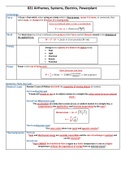021 Airframes, Systems, Electrics, Powerplant
Terminology
Force A Force is that which, when acting on a body which is free to move, causes it to move, or conversely, that
which stops, or changes the direction of a moving body.
Force is produced when a mass is accelerated.
𝒌𝒈∗𝒎
𝑭 = 𝒎 ∗ 𝒂 → (𝑁𝑒𝑤𝑡𝑜𝑛) ( 𝒔𝟐
)
Work The Work Done by a force is defined as the product of the Force and the Distance moved in the direction of
the applied force.
𝑾 = 𝑭 ∗ 𝑫 → (𝐽𝑜𝑢𝑙𝑒 𝑜𝑟 𝑓𝑜𝑜𝑡 𝑝𝑜𝑢𝑛𝑑𝑠)(𝑵 ∗ 𝒎)
Energy Energy is the capacity of a body to do work (Joule):
• Heat
• Light
• Chemical
• Kinetic
• Potential
Power Power is the rate of doing work.
Work Done per unit time.
𝐉 𝑓𝑜𝑜𝑡 𝑝𝑜𝑢𝑛𝑑
𝑷 = 𝐬 = 𝑊𝑎𝑡𝑡 → 33000 = ℎ𝑜𝑟𝑠𝑒𝑝𝑜𝑤𝑒𝑟
𝑚𝑖𝑛𝑢𝑡𝑒
Dynamics, Fluid, Gas Laws
Newton’s Laws Newton’s Laws of Motion deal with the properties of moving objects (or bodies):
First Law (Inertia Law)
“A body will remain at rest or in uniform motion in a straight line unless acted on by an external
force”.
Second Law (Momentum Law)
“The acceleration of a body from a state of rest, or uniform motion in a straight line, is
proportional to the applied force and inversely proportional to the mass”.
𝑘𝑔 ∗ 𝑚
𝑴𝒐𝒎𝒆𝒏𝒕𝒖𝒎 = 𝒎 ∗ 𝑽 ( )
𝑠
𝑭 𝑁
𝒂= ( )
𝒎 𝑘𝑔
Third Law (Reaction Law)
“For every action there is an equal and opposite reaction”.
Thermodynamics First Law
“Heat and Mechanical energy are mutually convertible and the rate of exchange is constant and
can be measured”.
Second Law
“Heat CANNOT be transferred from a region at a lower temperature to one at a higher
temperature without the expenditure of energy from an external source”.
,Bernoulli’s Total energy = Potential energy (height or position) + Pressure energy + Kinetic energy (movement)
Theorem
When considering the flow, potential energy is assumed to be constant.
For aerodynamic purposes:
𝑻𝒐𝒕𝒂𝒍 𝒆𝒏𝒆𝒓𝒈𝒚 = 𝒌𝒊𝒏𝒆𝒕𝒊𝒄 𝒆𝒏𝒆𝒓𝒈𝒚 + 𝒑𝒓𝒆𝒔𝒔𝒖𝒓𝒆 𝒆𝒏𝒆𝒓𝒈𝒚 = 𝑲
Venturi Tube
The Venturi (convergent/divergent duct) tube has an inlet which narrows to a throat, and an outlet
section, relatively longer, which increases in diameter towards the rear.
Constant Mass Flow (The continuity Equation)
𝑴𝒂𝒔𝒔 𝑭𝒍𝒐𝒘 = 𝑨𝒓𝒆𝒂 ∗ 𝑫𝒆𝒏𝒔𝒊𝒕𝒚 ∗ 𝑽𝒆𝒍𝒐𝒄𝒊𝒕𝒚 = 𝑲
Boyle’s Law “In a gas held at a constant temperature, the volume is inversely proportional to the pressure.”
At constant Temperature
𝑷∗𝑽=𝑲
P is the absolute pressure.
Charles’s Law or Gay-Lussac’s Law states:
“If any gas is held at a constant pressure, its volume is directly proportional to the absolute
temperature”.
At constant Pressure
𝑽
=𝑲
𝑻
Combined Gas
Combined Boyle’s and Charles’s Laws
Laws
𝑷∗𝑽
= 𝑲 →𝑷∗𝑽=𝑲∗𝑻
𝑻
𝑷𝟏 ∗ 𝑽𝟏 𝑷𝟐 ∗ 𝑽𝟐
=
𝑻𝟏 𝑻𝟐
,Terms and Formulae
Quantity Symbol Standard Units Formula
1 Potential Difference V Volts, V V = IR
2 Current I Amperes, A I = V/R
3 Resistance R Ohms, Ω R = V/I
P = V × I or
4 Power P Watts. W
P = I2R
Newtons, N
5 Force F F = ma
Pounds force, lbf
Kilograms, kg
6 Mass m F = ma
Pounds, lb
7 Density ρ kg/m3 or lb/ft3 ρ = m/V
Newton Metres
8 Moment M M=F ×d
Pounds Feet
9 Velocity v metres/sec ft/sec v = d/t
10 Acceleration a m/sec2 or ft/sec2 a = F/m
Pascals, Pa (N/m2)
11 Pressure P P = F/A
lb/in2
12 Area A m2 or in2 A = F/P
13 Volume m3 or ft3
14 Frequency Hertz, Hz cycles/sec
15 Work Done Joules, J or ft lb Wd = F × d
16 Potential Energy PE Joules, J PE = m × g × h
17 Kinetic Energy Joules, J KE =1/2mv2
Useful work output
18 Efficiency
Total energy input
, Diesel Engines
Levers Operate with a ‘single-lever’ concept similar to some turboprops:
• No throttle valves,
• No mixture controls,
• Power set/determined by fuel flow ONLY
Injection • Inlet valves shuts before the fuel is injected
Ignition Diesel DOES NOT REQUIRE an ignition-system:
Compression-ignition engine:
• Ignition is a function of the rise of temperature of the air due to compression.
Cold Starting:
• Glow-plugs or Pre-heaters which provide initial heating to the combustion-chamber area.
• Once started the fuel is injected into a zone where the temperatures are higher than the
flash-point of the fuel due to high compression ratios,
Detonation:
• Is quite normal.
• The diesel referred to as the ‘detonation-ignition’ engine.
• Constructed to withstand the additional pressures generated → Heavier engine.
Lubrication Typically, Wet-Sump include:
• Oil cooler to dissipate the additional heat generated by the diesel engine.
Fuel Diesel aero-engines use Aviation Turbine Gasoline or AVTUR (paraffin = kerosene):
• Less flammable → Less fire-hazard,
• Less volatile,
• Safer fuel option operationally than AVGAS,
• AVTUR is denser than AVGAS (with an SG of 0.8),
• Contains more energy per unit volume,
• For a given fuel load on board an aircraft, the range would be greater if AVTUR used.
Mixture Diesel engines generally RUN LEAN:
Air supply is not throttled fed unrestricted into the cylinder as a function of fuel delivery.
Icing • No carburettor → No carburettor Icing.
• Impact-icing (Air-Inlet filter Icing):
o Overcome by Ice-guards which by-pass the filter when it becomes blocked with ice.
• Waxing: fuel-solidification:
o Low Temperature → Fuel viscosity increased,
o Overcome by putting additives in the fuel,
o Fuel-heaters in the fuel-lines or filters to pre-heat the fuel.
Efficiency HIGHER COMPRESSION RATIO than petrol engine → HIGHER THERMAL EFFICIENCY
Compression Ratio Much higher compression-ratios:
• Compression Ratio: 25:1
• Fuel self-ignites thereby eliminating the need for a spark-generating system.
Power Turbochargers: (external superchargers) may be fitted to improve performance in a similar way
Augmentation to the conventional piston engine.
Intercoolers: employed to restore density after compression.





